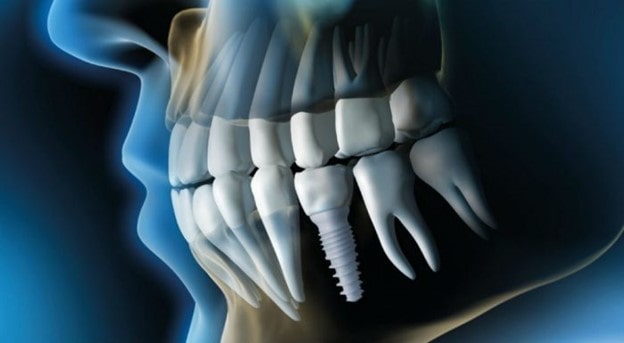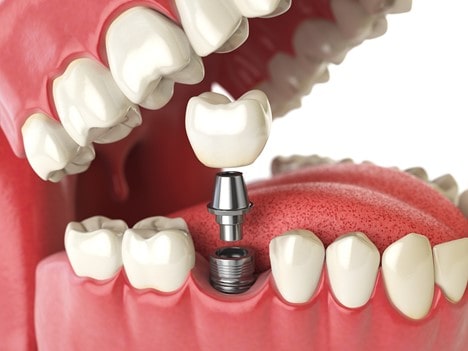A dental implant is a long-term, discreet solution for replacing missing or failing teeth. Having missing teeth can impact the way you eat and speak, which can knock your confidence.
Who is the Candidate for Dental Implants?
Most people who have one or more missing teeth are candidates for dental implants. You may need a dental implant if you lose a tooth due to:
- Cavities (tooth decay).
- Tooth root fracture.
- Clenching or grinding habit.
- Cleft lip (put this at the bottom of the list).
- Facial injury.
- Gum disease.
Types of Dental Implants
Dental implants are substitutes for the roots of missing teeth. Implants act as an anchor for a replacement tooth or crown or for an entire set of replacement teeth.
Root Form Implant
This is the most common type of implant. It is a screw type of implant, shaped like the root of a tooth, which is set directly into the jawbone under the gums. Implanting a root form implant is a surgical process which requires local anesthesia. It takes about three to six months for your gums to heal from this process. After healing, the implant is uncovered and a replacement tooth can be attached.
Plate Form Implant
A plate form implant is used when the jawbone is too narrow or short for a root form implant. The plate form implant is a flat, long implant which is set directly on top of the jawbone and under the gums. Bone and tissue will eventually grow around this type of implant, making it more secure. This type of implant is also called an endosteal implant.
Subperiosteal Implants
Another type of dental implant is Subperiosteal Implants. This is the main alternative to Endosteal Implants. Instead of being fixed into the jawbone, subperiosteal implants rests on top of the bone but still under the gum. A metal frame is placed under the gum with a post attached to it. The gum then heals around the frame to hold it in place. The false teeth are secured to the poles that come from the gum. This procedure is only used if the patient doesn’t have enough jawbone for an implant to be placed or if the person in question just doesn’t want to go through with intensive oral surgery to add bone to the area.
Dental Implant Procedure
Placing a dental implant has various stages. They are listed as below:
Placing the Implant
Thanks to the modern dentistry techniques, it’s possible to make the implant placement procedure comfortable and pain-free. Concerned patients can also ask the dentist for sedation to feel relaxed while a dental implant is placed. The procedure starts with the jawbone preparation, and the surgeon then makes a cut to expose the bone for drilling holes. The holes are kept deep enough for the implant to be placed properly and placed deep into the bone, like the root. The doctor may require bone grafting in cases where the bone is weak or lacks the strength to support implant surgery. The surgeon then waits for the jawbone to heal and after that, places the metal post in it. The entire process, from start to finish, may take many months where most of the time is spent on healing and waiting for the growth of new bone in the jaw. After this, a temporary crown is given to the patient which is placed to fill the gap, and also for achieving the aesthetic goal. This crown can be taken off for implant procedure, one has to wait until the bone is healed properly
Healing
During this process, the jawbone will grow and unite with the surface of the dental implant. This process is also referred to as osseointegration as it helps to offer a durable base for the new artificial tooth, much like roots do for the natural teeth. In general, this process takes between 3 to 6 months depending on the bone health & structure. However, the whole procedure can get completed in one day itself when patients have good bone structure. After that, you can schedule the second surgery but only once the implants are fused with the bone. Your dentists will take an x-ray to confirm whether the implant is fit for the second surgery. The second surgery will be simpler than the first where a new incision is made to expose the heads of the implants.
Placement of Permanent Crown
In the next stage, the dentist will focus on making the permanent crown look exactly like your natural teeth. All the elements like the surface texture, color and anatomy will be tuned up to blend with the surrounding dentition. If you are not happy with the crown for any reason, consult your dentist so that it can be sent back to the dental technician for necessary changes. Impressions of your mouth and remaining teeth are taken to make the crown so that a realistic-looking artificial tooth can be made. The crown, however, will not be placed until the jawbone is strong enough to support the new tooth. It takes less than 2 to 3 weeks to make a permanent crown which will then be cemented or screwed to the Implant.
Benefits and Risks of Dental Implants
Dental implants can significantly improve the quality of life and the health of a person who needs them. However, complications may sometimes occur. Complications can occur soon after dental implant placement or much later. Some complications result in implant failure (usually defined as implant looseness or loss). Implant failure can result in the need for another surgical procedure to fix or replace the implant system.
Benefits of Dental Implants:
- Restores the ability to chew
- Restores cosmetic appearance
- Helps keep the jawbone from shrinking due to bone loss
- Preserves the health of the surrounding bone and gums
- Helps keep adjacent (nearby) teeth stable
- Improves quality of life
Risks Associated with Dental Implants:
- Damage to surrounding natural teeth during implant placement
- Injury to the surrounding tissues during surgery, such as sinus perforation
- Injury during surgery (for example, fracture of surrounding jawbone)
- A sensation that the tooth is loose or twisting in place resulting from an abutment screw loosening
- Implant body failure (looseness of the implant body)
- due to systemic infection, which may be more likely in patients with uncontrolled diabetes
- due to local infection in bone and gums supporting the implant body
- due to delayed healing, which may be more likely in patients who smoke
How Do I Care for Dental Implants?
Dental implants require the same care as real teeth, including brushing, flossing, rinsing with an antibacterial mouthwash, and regular dental check-ups.
Scheduling
The first step to initiating dental implant treatment is to schedule a comprehensive examination. We will take a medical history, complete a clinical exam, take x-rays including a 3D image, and take impressions. We will then develop an individualized treatment plan to begin your implant journey. We will involve other specialists if necessary to provide the best treatment outcome possible.
If you wish to know more about dental implant treatment and find out if dental implants are the right option for you in Ladera Ranch, CA our team at mission dental implant center is ready answer any questions you might have.




